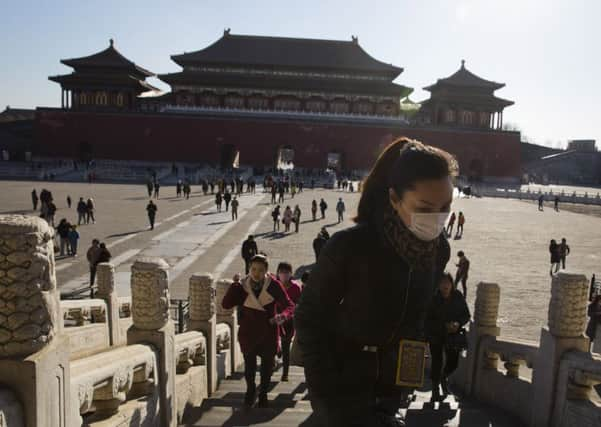Second Beijing smog alert forces car ban and schools closure


A wave of smog is due to settle over the city of 22.5 million from today until Tuesday. Levels of PM2.5, the smallest and deadliest airborne particles, are set to top 500, according to the official Beijing government website.
That is more than 20 times the level that is considered safe by the World Health Organisation. Half the city’s cars will be forced off the road on any given day, while barbecue grills and other outdoor smoke sources will be banned and factory production restricted. Schools will close and residents advised to avoid outdoor activities.
Advertisement
Hide AdAdvertisement
Hide AdVisibility in some parts of Beijing will fall to less than 500 meters on Tuesday when the smog will be at its worst, the city government website said.
Smog red alerts are triggered when levels of PM2.5 above 300 are forecast to last for more than 72 hours.
Although the four-tier smog warning system was launched two years ago, Beijing had not issued a red alert until last week, drawing accusations that it was ignoring serious bouts of smog to avoid the economic costs.
Some residents have defied the odd-even license plate number traffic restrictions and complained about the need to stay home from work to accompany housebound children. Others have used the break from school to travel to locales where the air is better.
Scientific studies attribute 1.4 million premature deaths per year to China’s smog, or almost 4,000 per day.
Most of the pollution is blamed on coal-fired power plants, along with vehicle emissions, building construction and factory work resulting from three decades of headlong economic expansion. While Beijing’s smog gets the most attention, the scourge strikes much of northern China on a regular basis, sometimes forcing the closure of highways because of poor visibility.
The world’s biggest carbon emitter, China plans to reduce hazardous emissions from coal-fired power plants by 50 percent over the next five years, and says its overall emissions will peak by about 2030 before starting to decline.
China still depends on coal for more than 60 percent of its electricity but is in the process of shifting to nuclear, solar and wind power.
Advertisement
Hide AdAdvertisement
Hide AdBeijing resident Cheng Xianke expressed concern for the health of the elderly and children. He said: “For us who commute to work it’s not so bad but still I’m very concerned about the pollution. I think the government needs to put more effort into solving this.”
Another resident, Fan Xiaoting, said that the alert would affect school teaching timetables: “We are paying close attention as to whether stopping the classes will have further implications.”
Online, many people questioned the government’s efforts to combat pollution. “I really don’t know what the government is doing? It can predict the smog but not take the appropriate measures beforehand, rather it’s letting the smog harm citizens,” said Weibo user Beijingpuer.
China still depends on coal for more than 60 per cent of its power, despite big investments in renewable energy. Earlier this month China was part of the landmark Paris climate change agreement.